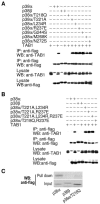Determinants that control the specific interactions between TAB1 and p38alpha
- PMID: 16648477
- PMCID: PMC1489000
- DOI: 10.1128/MCB.26.10.3824-3834.2006
Determinants that control the specific interactions between TAB1 and p38alpha
Abstract
Previous studies have revealed that transforming growth factor-beta-activated protein kinase 1 (TAB1) interacts with p38alpha and induces p38alpha autophosphorylation. Here, we examine the sequence requirements in TAB1 and p38alpha that drive their interaction. Deletion and point mutations in TAB1 reveal that a proline residue in the C terminus of TAB1 (Pro412) is necessary for its interaction with p38alpha. Furthermore, a cryptic D-domain-like docking site was identified adjacent to the N terminus of Pro412, putting Pro412 in the phi(B)+3 position of the docking site. Through mutational analysis, we found that the previously identified hydrophobic docking groove in p38alpha is involved in this interaction, whereas the CD domain and ED domain are not. Furthermore, chimeric analysis with p38beta (which does not bind to TAB1) revealed a previously unidentified locus of p38alpha comprising Thr218 and Ile275 that is essential for specific binding of p38alpha to TAB1. Converting either of these residues to the corresponding amino acid of p38beta abolishes p38alpha interaction with TAB1. These p38alpha mutants still can be fully activated by p38alpha upstream activating kinase mitogen-activated protein kinase kinase 6, but their basal activity and activation in response to some extracellular stimuli are reduced. Adjacent to Thr218 and Ile275 is a site where large conformational changes occur in the presence of docking-site peptides derived from p38alpha substrates and activators. This suggests that TAB1-induced autophosphorylation of p38alpha results from conformational changes that are similar but unique to those seen in p38alpha interactions with its substrates and activating kinases.
Figures









Similar articles
-
TAB1beta (transforming growth factor-beta-activated protein kinase 1-binding protein 1beta ), a novel splicing variant of TAB1 that interacts with p38alpha but not TAK1.J Biol Chem. 2003 Jan 24;278(4):2286-93. doi: 10.1074/jbc.M210918200. Epub 2002 Nov 11. J Biol Chem. 2003. PMID: 12429732
-
Crystal structure of the p38α MAP kinase in complex with a docking peptide from TAB1.Sci China Life Sci. 2013 Jul;56(7):653-60. doi: 10.1007/s11427-013-4494-0. Epub 2013 May 31. Sci China Life Sci. 2013. PMID: 23722236
-
Mechanism and consequence of the autoactivation of p38α mitogen-activated protein kinase promoted by TAB1.Nat Struct Mol Biol. 2013 Oct;20(10):1182-90. doi: 10.1038/nsmb.2668. Epub 2013 Sep 15. Nat Struct Mol Biol. 2013. PMID: 24037507 Free PMC article.
-
Disruption of TAB1/p38α interaction using a cell-permeable peptide limits myocardial ischemia/reperfusion injury.Mol Ther. 2013 Sep;21(9):1668-77. doi: 10.1038/mt.2013.90. Epub 2013 Jul 23. Mol Ther. 2013. PMID: 23877036 Free PMC article.
-
Three-dimensional docking in the MAPK p38α.Sci Signal. 2011 Dec 20;4(204):pe47. doi: 10.1126/scisignal.2002697. Sci Signal. 2011. PMID: 22375047 Review.
Cited by
-
Hydrogen-exchange mass spectrometry reveals activation-induced changes in the conformational mobility of p38alpha MAP kinase.J Mol Biol. 2008 Jun 20;379(5):1075-93. doi: 10.1016/j.jmb.2008.04.044. Epub 2008 Apr 25. J Mol Biol. 2008. PMID: 18501927 Free PMC article.
-
Amyloidogenic light chains induce cardiomyocyte contractile dysfunction and apoptosis via a non-canonical p38alpha MAPK pathway.Proc Natl Acad Sci U S A. 2010 Mar 2;107(9):4188-93. doi: 10.1073/pnas.0912263107. Epub 2010 Feb 11. Proc Natl Acad Sci U S A. 2010. PMID: 20150510 Free PMC article.
-
The p38 Pathway: From Biology to Cancer Therapy.Int J Mol Sci. 2020 Mar 11;21(6):1913. doi: 10.3390/ijms21061913. Int J Mol Sci. 2020. PMID: 32168915 Free PMC article. Review.
-
Ubiquitin plays an atypical role in GPCR-induced p38 MAP kinase activation on endosomes.J Cell Biol. 2015 Sep 28;210(7):1117-31. doi: 10.1083/jcb.201504007. Epub 2015 Sep 21. J Cell Biol. 2015. PMID: 26391660 Free PMC article.
-
Fluorescence resonance energy transfer (FRET) spatiotemporal mapping of atypical P38 reveals an endosomal and cytosolic spatial bias.Sci Rep. 2023 May 8;13(1):7477. doi: 10.1038/s41598-023-33953-y. Sci Rep. 2023. PMID: 37156828 Free PMC article.
References
-
- Anderson, N. G., J. L. Maller, N. K. Tonks, and T. W. Sturgill. 1990. Requirement for integration of signals from two distinct phosphorylation pathways for activation of MAP kinase. Nature 343:651-653. - PubMed
-
- Barsyte-Lovejoy, D., A. Galanis, and A. D. Sharrocks. 2002. Specificity determinants in MAPK signaling to transcription factors. J. Biol. Chem. 277:9896-9903. - PubMed
-
- Bell, M., R. Capone, I. Pashtan, A. Levitzki, and D. Engelberg. 2001. Isolation of hyperactive mutants of the MAPK p38/Hog1 that are independent of MAPK kinase activation. J. Biol. Chem. 276:25351-25358. - PubMed
-
- Brunner, D., N. Oellers, J. Szabad, W. H. Biggs III, S. L. Zipursky, and E. Hafen. 1994. A gain-of-function mutation in Drosophila MAP kinase activates multiple receptor tyrosine kinase signaling pathways. Cell 76:875-888. - PubMed
-
- Chang, C. I., B. E. Xu, R. Akella, M. H. Cobb, and E. J. Goldsmith. 2002. Crystal structures of MAP kinase p38 complexed to the docking sites on its nuclear substrate MEF2A and activator MKK3b. Mol. Cell 9:1241-1249. - PubMed
Publication types
MeSH terms
Substances
Grants and funding
LinkOut - more resources
Full Text Sources
Miscellaneous
